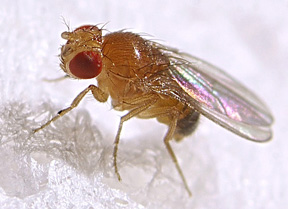Fruit fly gene from 'out of nowhere' may change ideas about how new genes are formed, researchers report
By Krishna Ramanujan

Scientists thought that most new genes were formed from existing genes, but Cornell researchers have discovered a gene in some fruit flies that appears to be unrelated to other genes in any known genome.
The new gene, called hydra, exists in only a small number of species of Drosophila fruit flies, which suggests it was created about 13 million years ago, when these melanogaster subgroup species diverged from a common ancestor.
And early evidence indicates that the new gene is functional (as opposed to being nonfunctional "junk" DNA) and is likely to express a protein involved in late stages of sperm cell development (spermatogenesis). This finding is consistent with work of other scientists who are discovering that many of the most recently formed functional genes in any species also are expressed in male testes and appear related to spermatogenesis.
"This is a de novo -- 'out of nowhere' -- gene," said Hsiao-Pei Yang, a senior research associate in Cornell's Department of Molecular Biology and Genetics and senior author of a paper published in the July 6 issue of the online journal PLoS Genetics (Public Library of Science Genetics). "People used to think that new genes were always formed from tinkering with other genes, but with this gene we can find no homologues [genes with a similar structure]. You cannot find any related genes in the fly genome or any species' genome, and that is what is unique."
Yang conducted part of this research while at the National Yang-Ming University in Taiwan and part of the work in collaboration with Cornell's Daniel Barbash, assistant professor of molecular biology and genetics.
The researchers do not yet know how the hydra gene was created, but they speculate that the gene may have developed from a piece of DNA junk called a transposable element (also known as a "jumping gene"), which may have been inserted into the genome by a virus. These transposons are known to copy and insert themselves into DNA sequences. For example, one theory is that when a transposon sits next to a gene and then jumps to a new location, it carries part of the gene sequence it was next to and inserts it in the new location. Often, transposable elements appear to have no function or may be harmful and are eliminated by natural selection, but researchers are beginning to think transposons may be a source for creating new functional genes as well.
The hydra gene is named after the Greek mythological beast that had a hound's body and nine snake heads, because it has nine duplicated first exons (sections of the gene that contain protein-coding information). Each of these exons may serve as alternative starting positions for the gene to become activated. The researchers found that most of these exons had a sequence for a transposable element sitting right next to it. Duplicated sequences generated by transposons may be part of the mechanism for creating new genes, as the duplications provide more chances for a gene to evolve.
The work was funded by the National Sciences Council in Taiwan.
Media Contact
Get Cornell news delivered right to your inbox.
Subscribe